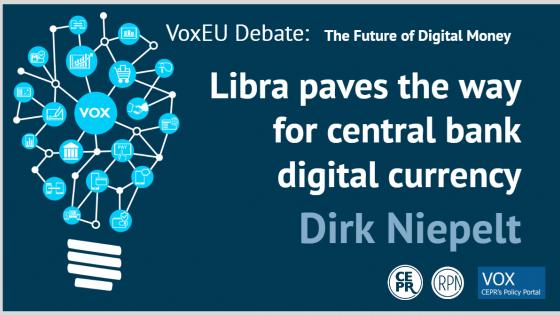This column is a lead commentary in the VoxEU Debate "The Future of Digital Money"
Plans by Facebook and its partners to launch Libra, a global digital currency, are at an early stage but they have focused minds. ‘Old finance’ frets about the prospective new competitor; the FinTech sphere is buzzing with rumours; and regulators, central banks, and legislators alike are worried. Lack of detail in the Libra whitepaper adds to the nervousness.
Are we witnessing a seismic shift in the monetary system? Probably, but Libra’s role in that shift is going to be an indirect one. Rather than the protagonist, Libra will be a catalyst for monetary change – a change that is driven, nolens volens, by regulators, central banks, and traditional financial intermediaries.
Digital currencies
What is a global digital currency of the type the Libra consortium wishes to issue? It is helpful to distinguish two aspects of such a ‘stablecoin’ (i.e. an asset-backed digital token). The first relates to use: the token constitutes a versatile and efficient medium of exchange for domestic and international payments, both retail and wholesale. Its digital nature keeps transaction costs low, thereby shifting bargaining power from existing payment service providers to their customers and offering the unbanked affordable access to basic finance. It also allows payment and settlement systems to be better integrated. A successful digital currency exploits network externalities to their fullest extent, gaining stature due to its versatility and user base and broadening the user base because of its stature.
The second aspect relates to the assets that back the digital token. In Libra’s case, these assets are to include securities and bank deposits denominated in the currencies of a few advanced economies. In other cases, stablecoins are backed by securities denominated in a single currency. In their purest form, the latter stablecoins constitute claims on central bank money of a single monetary authority. If the claims are direct, then the tokens are central bank digital currency (CBDC) or ‘Reserves for All’ (Niepelt 2015). If they are indirect – i.e. mediated by a bank or a fund – then they constitute ‘synthetic CBDC’ (Adrian and Mancini-Griffoli 2019).1
Inherent tradeoffs
Beyond the benefits for individual users, digital currencies can have wide-ranging macroeconomic implications. For a start, their introduction may affect banks in their role as issuers of money; if mismanaged, this can have repercussions for financial intermediation and stability. At the global level, a widely adopted digital currency alters the relative standing of national currencies. Carney (2019) emphasises the upside of such an unravelling of the current international financial architecture with its outsized role of the US dollar. But there are also risks, at least for those countries that would see demand for their national currencies fall and capital flee. For them, a successful new digital currency would have similar macroeconomic implications as conventional dollarization (Niepelt 2016, Hamilton 2019, Adrian and Mancini-Griffoli 2019).
With any global digital currency of note, policymakers confront new tradeoffs: financial inclusion of the unbanked and enlarged financial choice sets for citizens suffering from financial repression come at the cost of lower government revenues (in the countries whose citizens benefit), possibly more volatile capital flows, and lower rents in the banking sector. The benefits that arise from large network externalities are the mirror image of increased financial stability risks as well as the danger that transaction data are monopolised and consumer sovereignty curtailed. And a payment system that aims at convenience and hassle-free cross-border payments likely compromises on the prevention of illicit transactions.2
Inferior Libra
But with Libra, these tradeoffs are less favourable than with ‘Reserves for All’ or a synthetic CBDC, for several reasons. First, because central banks and regulators can more easily guarantee consumer protection, ensure privacy standards, and check the legitimacy of payments when they are directly engaged in the provision of a digital currency. In principle, a private currency issuer such as the Libra consortium can be regulated and monitored to the same effect. But as experience shows (certainly in the case of Facebook), this is hard in practice when interests are sufficiently misaligned.
Similarly, tradeoffs that involve macroeconomic effects of a digital currency (and their international repercussions) can better be managed if the authorities traditionally in charge of macroeconomic and financial stabilisation – central banks, financial regulators, and finance ministries – are active players rather than passive bystanders.3 In fact, central bank control over a digital currency lets the monetary authority effectively eliminate all macroeconomic downside risks that arise from the currency’s introduction. Under general conditions, a central bank can always ensure, at a minimum, that a swap of CBDC for deposits does not have negative macroeconomic consequences (Brunnermeier and Niepelt 2019a, 2019b, 2019c).
Third, Libra would also offer smaller benefits to consumers and businesses than CBDC because the portfolio composition of the ‘Libra Reserve’ would expose them to excessive exchange rate risk. A means of payment is particularly useful when it is denominated in the local unit of account.4 This is why consumers and businesses in the US prefer to transact in US dollars, the currency everybody else in their neighbourhood uses, rather than in euros. And it explains why, according to Koning (2019), global monies have a miserable track record. Libra according to current design would not offer the local-unit-of-account advantage because the ‘Libra Reserve’ would be invested in multiple currencies. Even if the circulating Libras were always fully backed, their exchange rate relative to national currencies thus would fluctuate, exposing users to unwarranted risks.5
Finally, the institutional setup behind Libra could put the currency’s liquidity at risk, exposing users to additional uncertainty that a (synthetic or not) CBDC would not bring about. According to the whitepaper, only resellers, who stand between users and the ‘Libra Reserve’, were to redeem Libras against assets in the reserve; that is, only resellers could provide liquidity in times of falling aggregate Libra demand. But whether resellers would actually have an incentive to provide this liquidity is unclear. Since Libras would constitute claims to the assets in the ‘Libra Reserve’ but not to the returns on those assets (which the Libra consortium plans to pocket), resellers might want to redeem at the earliest possibility and keep the assets for themselves (Zellweger-Gutknecht and Niepelt 2019).
Conclusion
Many other aspects of the proposed Libra architecture remain in the dark.6 What is clear, however, is that CBDC dominates a Libra-type stablecoin in almost all respects.7
When confronted with the choice between the status quo and a new financial architecture with CBDC, most central banks have responded cautiously. But Libra or its next best replica will take this choice off the table – the status quo ceases to be an option. The new choice for monetary authorities and regulators will be one between central bank managed CBDC on the one hand and – riskier – private digital tokens on the other. Central banks have a strong interest to maintain control over the payment system as well as the financial sector more broadly and to defend the attractiveness of their home currency. Nolens volens, they will therefore introduce ‘Reserves for All’or promote synthetic CBDCs. In economics, things take longer than one thinks they will, as Rudi Dornbusch quipped, but then they happen faster than one thought they could.
References
Adrian, T and T Mancini-Griffoli (2019), “The rise of digital currency”, VoxEU, 28 August.
Bank for International Settlement (2019), “Big tech in finance: opportunities and risks”, Chapter 3 in BIS Annual Economic Report.
Brunnermeier, M K, H James and J-P Landau (2019), “Digital currency areas”, VoxEU, 3 July.
Brunnermeier, M K and D Niepelt (2019a), “On the equivalence of private and public money”, Journal of Monetary Economics (forthcoming).
Brunnermeier, M K and D Niepelt (2019b), “Digital money: Private versus public”, in A Fatás (ed.), The Economics of Fintech and Digital Currencies, VoxEU eBook, March.
Brunnermeier, M K and D Niepelt (2019c), “Public versus private digital money: Macroeconomic (ir)relevance”, VoxEU, 20 March.
Carney, M (2019), “The growing challenges for monetary policy in the current international monetary and financial system”, Speech given at the Jackson Hole Symposium, 23 August.
Cecchetti, S and K Schoenholtz (2019), “Libra: A dramatic call to regulatory action”, VoxEU, 28 August.
Eichengreen, B (2019), “Libra: The known unknowns and unknown unknowns”, VoxEU, 28 August.
Fatás, A and B Weder di Mauro (2019), “The benefits of a global digital currency”, VoxEU, 30 August.
Hamilton, J (2019), “Libra: Economics of Facebook’s cryptocurrency”, econbrowser, 24 June.
Koning, JP (2019), “Esperanto, money's interval of certainty, and how this applies to Facebook's Libra”, Moneyness, 25 June.
Lopp, J (2019), “How will Facebook’s Libra ‘blockchain’ really work?”, OneZero, 18 June.
Niepelt, D (2015), “Reserves for everyone—towards a new monetary regime?”, VoxEU, 21 January.
Niepelt, D (2016), “Central banking and bitcoin: Not yet a threat”, VoxEU, 19 October.
Niepelt, D (2018), “Reserves for All? Central bank digital currency, deposits, and their (non)-equivalence”, CEPR Discussion Paper 13065, May.
Niepelt, D (2020), “Reserves for All? Central bank digital currency, deposits, and their (non)-equivalence”, International Journal of Central Banking (forthcoming).
Williamson, S (2019), “Libra: Financial inclusion for the world's poor, or scam?”, New Monetarism, 21 June.
Zellweger-Gutknecht, C and D Niepelt (2019), “Das Geschäftsmodell hinter Libra [Libra’s business model],” Jusletter, 1 July.
Endnotes
[1] See also Brunnermeier et al. (2019) on the prospect of ‘digital currency areas’ as compared to traditional, geographically delimited currency areas.
[2] For a discussion of some of these risks, see BIS (2019), Adrian and Mancini-Griffoli(2019), Cecchetti and Schoenholtz (2019), or Fatás and Weder di Mauro (2019).
[3] See also Adrian and Mancini-Griffoli(2019) on the benefits of narrow-bank like synthetic CBDCs compared with money-market-fund like institutions akin to shadow banks.
[4] However, see Brunnermeier et al. (2019).
[5] Cecchetti and Schoenholtz (2019) and Fatás and Weder di Mauro (2019) offer an estimate of the magnitude of this risk and assess the welfare implications. Note that investors seeking to diversify their currency exposures do not need Libra. They can directly choose the currency composition of their portfolios, in a world with digital currencies for example by holding the CBDCs issued by different central banks.
[6] These aspects include the database structure and actual technical implementation (e.g. Lopp 2019) and legal questions regarding licensing in Switzerland (Zellweger-Gutknecht and Niepelt 2019). See also Eichengreen (2019) and Williamson (2019).
[7] There is one factor that favours a private-sector, Libra type arrangement over a public sector solution, namely, political economy. For a discussion, see Niepelt (2018, 2020).



